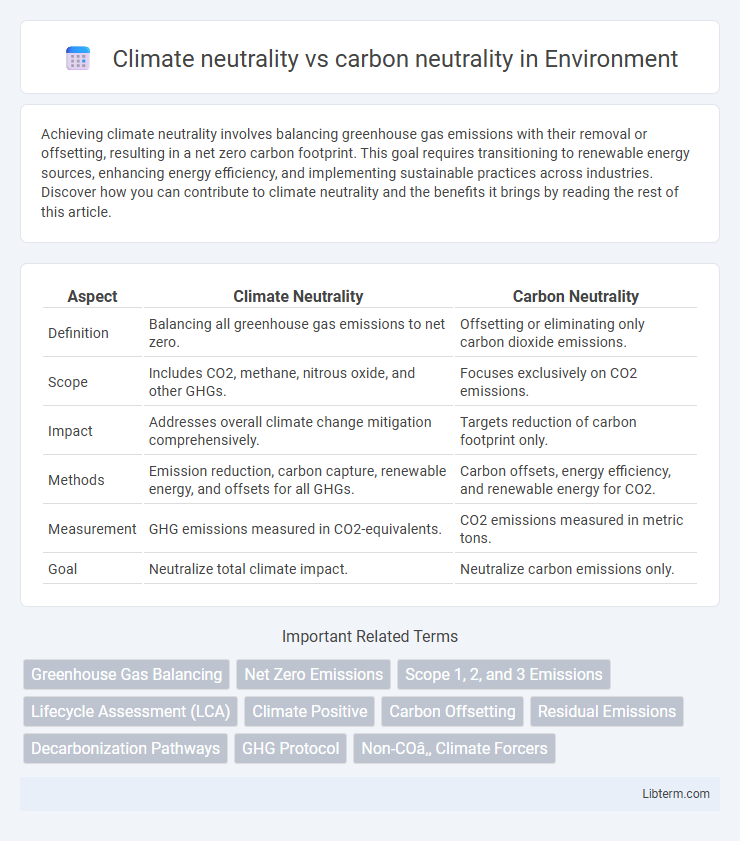Achieving climate neutrality involves balancing greenhouse gas emissions with their removal or offsetting, resulting in a net zero carbon footprint. This goal requires transitioning to renewable energy sources, enhancing energy efficiency, and implementing sustainable practices across industries. Discover how you can contribute to climate neutrality and the benefits it brings by reading the rest of this article.
Table of Comparison
| Aspect | Climate Neutrality | Carbon Neutrality |
|---|---|---|
| Definition | Balancing all greenhouse gas emissions to net zero. | Offsetting or eliminating only carbon dioxide emissions. |
| Scope | Includes CO2, methane, nitrous oxide, and other GHGs. | Focuses exclusively on CO2 emissions. |
| Impact | Addresses overall climate change mitigation comprehensively. | Targets reduction of carbon footprint only. |
| Methods | Emission reduction, carbon capture, renewable energy, and offsets for all GHGs. | Carbon offsets, energy efficiency, and renewable energy for CO2. |
| Measurement | GHG emissions measured in CO2-equivalents. | CO2 emissions measured in metric tons. |
| Goal | Neutralize total climate impact. | Neutralize carbon emissions only. |
Defining Climate Neutrality
Climate neutrality involves balancing all greenhouse gas emissions with removal or offset actions to achieve net-zero impact on the climate system, addressing CO2 and other greenhouse gases like methane and nitrous oxide. It differs from carbon neutrality, which specifically targets only carbon dioxide emissions through reduction and offset strategies. Achieving climate neutrality requires comprehensive measures across sectors to mitigate all climate pollutants and enhance carbon sinks, aligning with global efforts to limit temperature rise to 1.5degC.
Understanding Carbon Neutrality
Carbon neutrality refers to balancing emitted carbon dioxide with an equivalent amount of carbon removal or offset, aiming to achieve net-zero carbon emissions. It specifically targets greenhouse gases released during activities such as energy consumption, transportation, and industrial processes. Understanding carbon neutrality involves recognizing strategies like carbon offsetting, renewable energy adoption, and carbon capture technologies to mitigate environmental impact.
Key Differences Between Climate and Carbon Neutrality
Climate neutrality encompasses reducing all greenhouse gas emissions and balancing residual emissions with removal efforts across sectors, while carbon neutrality targets only carbon dioxide emissions. Climate neutrality requires comprehensive strategies including methane, nitrous oxide, and fluorinated gases management, unlike carbon neutrality's exclusive focus on carbon footprints. The broader scope of climate neutrality demands integrated policies addressing multiple emission sources for sustainable environmental impact.
The Scope of Emissions Covered
Climate neutrality encompasses all greenhouse gas emissions across an organization's entire value chain, including direct emissions, indirect emissions from purchased electricity, and emissions from upstream and downstream activities. Carbon neutrality specifically targets carbon dioxide (CO2) emissions, often focusing on operational emissions and sometimes excluding other greenhouse gases like methane or nitrous oxide. Understanding the scope of emissions covered is critical for accurately measuring impact and developing comprehensive strategies for achieving sustainability goals.
Strategies for Achieving Climate Neutrality
Strategies for achieving climate neutrality involve comprehensive approaches such as transitioning to renewable energy sources, enhancing energy efficiency, and implementing carbon capture and storage technologies. Promoting circular economy practices and sustainable land use further supports reducing greenhouse gas emissions beyond carbon dioxide. Integrating these actions with robust policy frameworks and stakeholder engagement ensures a holistic approach to neutralizing the full spectrum of climate impacts.
Methods to Achieve Carbon Neutrality
Achieving carbon neutrality involves methods such as carbon offsetting through reforestation, investing in renewable energy like solar and wind, and enhancing energy efficiency in industry and transportation. Carbon capture and storage (CCS) technologies also play a crucial role by directly capturing CO2 emissions from fossil fuel use. These strategies contrast with climate neutrality, which encompasses broader greenhouse gas reductions and ecosystem restoration beyond carbon alone.
The Role of Offsetting in Neutrality Goals
Climate neutrality encompasses balancing greenhouse gas emissions from all climate-relevant sources with removals, while carbon neutrality specifically targets net-zero carbon dioxide emissions. Offsetting plays a crucial role in both approaches by compensating emissions through projects like reforestation, renewable energy, and carbon capture technologies. Effective offsetting ensures that residual emissions are neutralized, supporting organizations and countries in achieving their climate or carbon neutrality targets aligned with the Paris Agreement.
Corporate Responsibility: Climate vs. Carbon Approaches
Corporate responsibility in climate neutrality embraces broader environmental impacts by targeting net-zero greenhouse gas emissions, including carbon dioxide, methane, and nitrous oxide, across all operational scopes. Carbon neutrality specifically focuses on balancing carbon dioxide emissions by reducing and offsetting CO2 output, often emphasizing short-term climate goals. Companies adopting climate neutrality strategies engage in comprehensive sustainability initiatives, integrating renewable energy, sustainable supply chains, and emissions reduction beyond carbon to address long-term climate resilience effectively.
Policy and Regulatory Perspectives
Climate neutrality policies encompass comprehensive strategies aimed at reducing all greenhouse gas emissions to net zero, with regulatory frameworks often requiring sectors to adopt sustainable energy sources and implement carbon capture technologies. Carbon neutrality regulations typically focus on balancing carbon dioxide emissions through offset mechanisms such as reforestation or carbon credits, with compliance driven by emission trading systems and national carbon pricing schemes. Policymakers are increasingly integrating climate neutrality targets into long-term climate action plans, mandating periodic reporting and stricter emission reduction commitments to meet the goals of international agreements like the Paris Accord.
Future Trends in Environmental Neutrality
Future trends in environmental neutrality emphasize an integrated approach, combining climate neutrality and carbon neutrality to achieve broader sustainability goals. Innovations in renewable energy, carbon capture technologies, and circular economy practices drive the transition toward net-zero emissions across industries and governments. Increasing regulatory frameworks and corporate commitments signal a global shift towards comprehensive environmental neutrality by 2050.
Climate neutrality Infographic

 libterm.com
libterm.com